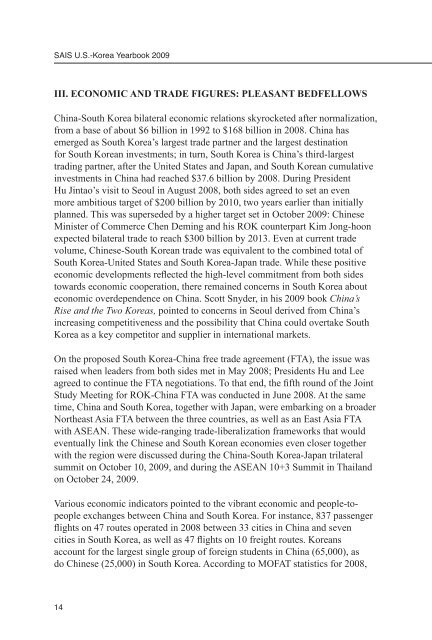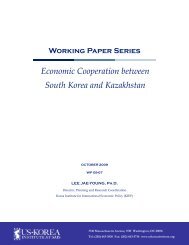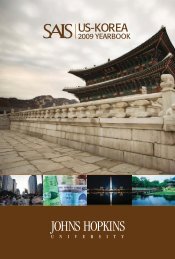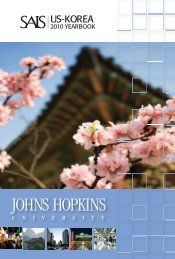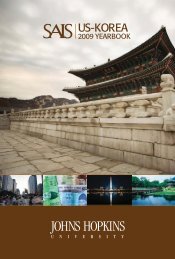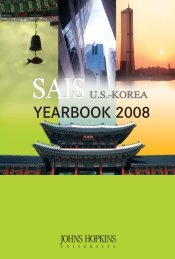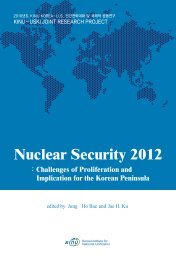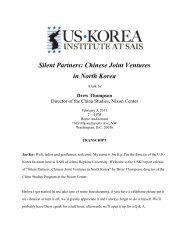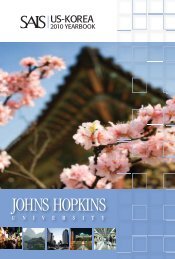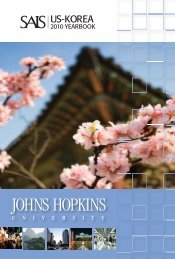US-Korea Institute at SAIS
US-Korea Institute at SAIS
US-Korea Institute at SAIS
- No tags were found...
Create successful ePaper yourself
Turn your PDF publications into a flip-book with our unique Google optimized e-Paper software.
<strong>SAIS</strong> U.S.-<strong>Korea</strong> Yearbook 2009<br />
III. ECONOMIC AND TRADE FIGURES: PLEASANT BEDFELLOWS<br />
China-South <strong>Korea</strong> bil<strong>at</strong>eral economic rel<strong>at</strong>ions skyrocketed after normaliz<strong>at</strong>ion,<br />
from a base of about $6 billion in 1992 to $168 billion in 2008. China has<br />
emerged as South <strong>Korea</strong>’s largest trade partner and the largest destin<strong>at</strong>ion<br />
for South <strong>Korea</strong>n investments; in turn, South <strong>Korea</strong> is China’s third-largest<br />
trading partner, after the United St<strong>at</strong>es and Japan, and South <strong>Korea</strong>n cumul<strong>at</strong>ive<br />
investments in China had reached $37.6 billion by 2008. During President<br />
Hu Jintao’s visit to Seoul in August 2008, both sides agreed to set an even<br />
more ambitious target of $200 billion by 2010, two years earlier than initially<br />
planned. This was superseded by a higher target set in October 2009: Chinese<br />
Minister of Commerce Chen Deming and his ROK counterpart Kim Jong-hoon<br />
expected bil<strong>at</strong>eral trade to reach $300 billion by 2013. Even <strong>at</strong> current trade<br />
volume, Chinese-South <strong>Korea</strong>n trade was equivalent to the combined total of<br />
South <strong>Korea</strong>-United St<strong>at</strong>es and South <strong>Korea</strong>-Japan trade. While these positive<br />
economic developments reflected the high-level commitment from both sides<br />
towards economic cooper<strong>at</strong>ion, there remained concerns in South <strong>Korea</strong> about<br />
economic overdependence on China. Scott Snyder, in his 2009 book China’s<br />
Rise and the Two <strong>Korea</strong>s, pointed to concerns in Seoul derived from China’s<br />
increasing competitiveness and the possibility th<strong>at</strong> China could overtake South<br />
<strong>Korea</strong> as a key competitor and supplier in intern<strong>at</strong>ional markets.<br />
On the proposed South <strong>Korea</strong>-China free trade agreement (FTA), the issue was<br />
raised when leaders from both sides met in May 2008; Presidents Hu and Lee<br />
agreed to continue the FTA negoti<strong>at</strong>ions. To th<strong>at</strong> end, the fifth round of the Joint<br />
Study Meeting for ROK-China FTA was conducted in June 2008. At the same<br />
time, China and South <strong>Korea</strong>, together with Japan, were embarking on a broader<br />
Northeast Asia FTA between the three countries, as well as an East Asia FTA<br />
with ASEAN. These wide-ranging trade-liberaliz<strong>at</strong>ion frameworks th<strong>at</strong> would<br />
eventually link the Chinese and South <strong>Korea</strong>n economies even closer together<br />
with the region were discussed during the China-South <strong>Korea</strong>-Japan tril<strong>at</strong>eral<br />
summit on October 10, 2009, and during the ASEAN 10+3 Summit in Thailand<br />
on October 24, 2009.<br />
Various economic indic<strong>at</strong>ors pointed to the vibrant economic and people-topeople<br />
exchanges between China and South <strong>Korea</strong>. For instance, 837 passenger<br />
flights on 47 routes oper<strong>at</strong>ed in 2008 between 33 cities in China and seven<br />
cities in South <strong>Korea</strong>, as well as 47 flights on 10 freight routes. <strong>Korea</strong>ns<br />
account for the largest single group of foreign students in China (65,000), as<br />
do Chinese (25,000) in South <strong>Korea</strong>. According to MOFAT st<strong>at</strong>istics for 2008,<br />
14


